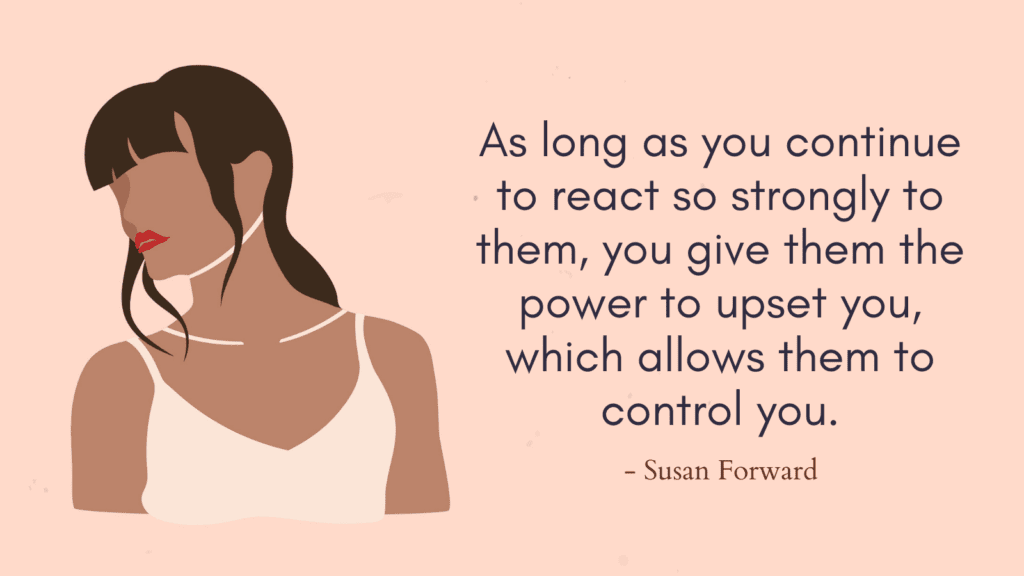In this post, you’re going to learn all about narcissist blame shifting and how to deal with it.
Who Is The Narcissist?
A narcissist is someone who has an excessive sense of self-importance, a deep need for admiration and attention, and usually lacks empathy for others.
They often have an inflated sense of their own abilities and achievements, and may constantly seek validation from others.
Narcissists can be self-centered, manipulative, and have difficulty considering the needs and feelings of others.
Narcissism exists on a spectrum. Not every person with narcissistic traits can be diagnosed with Narcissistic Personality Disorder.
What Is Narcissist Blame Shifting?
Narcissist blame shifting is a term used to describe the behavior of narcissistic individuals who regularly avoid taking responsibility for their actions or mistakes.
Instead of acknowledging their faults or wrongdoing, they shift the blame onto others.
This manipulation tactic allows them to maintain their image of superiority and protect their fragile ego.
Narcissists often have a grandiose sense of self-importance and believe they are above criticism.
When confronted with their wrongdoings or asked to take accountability for their actions, they feel threatened and may react defensively.
Blame shifting is a common defense mechanism they use to redirect the focus onto someone else, making it appear as though they are innocent or victimized.
Related: Narcissist Baiting – What it is, Why it Happens, and How to Stop it
Narcissist Blame Shifting Examples
Here are a few manifestations of narcissistic blame shifting:
1. Personal attacks
A narcissist may shift the blame onto others by attacking their character or pointing out their flaws in an attempt to divert attention from their own responsibility.
For example, if someone confronts a narcissist about their hurtful behavior, they might respond with, “You’re too sensitive, and it’s your fault for taking everything so personally.”
Related: Narcissist Word Salad: 12 Strategies & Examples
2. Gaslighting
Gaslighting refers to a form of manipulation and psychological abuse in which someone tries to make another person doubt their own reality, memory, or perception.
Narcissists often employ gaslighting techniques to make others doubt their own perception of reality.
They might manipulate situations and distort facts to make others believe that they are to blame.
For instance, if confronted about their dishonesty, a narcissist may say, “You’re imagining things. I never said that,” causing the other person to question their own memory.
Related: 10 Signs of Gaslighting (+FREE Worksheets)
3. Playing the victim
When faced with criticism or accountability, narcissists often shift the blame by portraying themselves as the victim.
They may use stories of past trauma or hardship to gain sympathy and elicit a protective reaction from others.
By playing the victim, the narcissist deflects attention away from their own actions and redirects it towards themselves.
For example, if questioned about their constant need for validation, a narcissist might respond with, “You have no idea how hard it is for me to feel loved. You just don’t understand.”
Related: Do Narcissists Cry?
4. Minimizing or denying responsibility
Narcissists frequently refuse to take responsibility for their actions and instead minimize or completely deny any wrongdoing.
They might manipulate words or present alternative narratives to downplay their role.
For instance, if caught in a lie, a narcissist may say, “I didn’t lie; I just didn’t tell you the whole truth.”
Related: The Narcissist’s Prayer Explained
5. Deflecting blame onto others
Narcissists commonly shift blame by redirecting attention onto someone else, pointing out their faults or mistakes as a way to avoid being held accountable.
They might say something like, “Yes, I made a mistake, but it’s nothing compared to what you did. Let’s talk about your flaws for a change.”
It’s important to note that these examples may not encompass all manifestations of blame shifting by narcissists, as individuals can employ various tactics depending on the circumstances.
Related: 5 Weird Things Covert Narcissists Do To Manipulate Their Victims
Why Narcissists Use Blame Shifting?
There are several factors that contribute to this behavior:
1. Self-enhancement: Narcissists have an intense need to feel superior and flawless. They will often shift blame onto others in order to maintain their self-perception of perfection. By attributing responsibility to someone else, they protect themselves from feeling inadequate or flawed.
2. Narcissistic entitlement: Narcissists believe they are entitled to special treatment and that rules don’t apply to them. When confronted with their own mistakes or shortcomings, they may refuse to take responsibility and instead direct blame towards others. This allows them to avoid feelings of shame or guilt.
3. Externalization of responsibility: Blame shifting is a way for narcissists to externalize their problems and avoid taking personal accountability. They may see themselves as victims and portray others as the source of their difficulties. By placing blame elsewhere, they can maintain a sense of control over their lives and avoid facing any unpleasant truths about themselves.
Related: Why Do Narcissists Ignore You? Top 7 Reasons
4. Projection: Narcissists tend to project their negative qualities onto others. They may unconsciously disown their own flaws and faults by attributing them to someone else. Blame shifting can function as a way for them to deny their own imperfections and maintain a positive self-image.
5. Manipulation and control: Blame shifting can be used as a manipulative tactic to control and manipulate others. By deflecting blame onto someone else, narcissists can avoid consequences and gain power over a situation. They may also use this tactic to confuse and convince others of their innocence.
While blame shifting is a common trait in narcissistic individuals, it may not be present in every narcissistic person.
Moreover, blame shifting can occur in individuals without narcissistic traits, depending on the circumstances.
Related: How Does A Narcissist React When You Stop Chasing Them?

The Emotional Toll of Narcissist Blame Shifting
The emotional toll of narcissist blame shifting can be profound and deeply damaging to one’s sense of self-worth and mental well-being.
Victims of this behavior often find themselves questioning their own sanity, feeling constantly invalidated and doubting their own perceptions of reality.
The narcissist’s ability to twist the truth and shift blame onto their victims can create a constant state of confusion and self-doubt, leaving the victims feeling trapped and unable to trust their own instincts.
For example, suppose a narcissistic partner consistently cheats and betrays their significant other. Instead of facing the consequences, they may blame their partner for not being attentive enough or for driving them towards infidelity.
This manipulation can cause the victim to carry an overwhelming burden of guilt, shame, and anxiety, leading to depression and a loss of self-esteem.
It takes a significant amount of strength and support for victims to break free from the grip of narcissistic blame shifting and regain their sense of self-worth.
Related: 60 Things Narcissistic Mothers Say
How to Deal With Narcissist Blame Shifting?
Here are a few suggestions that may help:
1. Recognize that it’s not your fault
Blame shifting is a manipulative tactic employed by narcissists to avoid taking responsibility for their actions.
Remind yourself that their behavior is not a reflection of your worth or character.
Related: Breaking Trauma Bond With A Narcissist
2. Seek support from trusted individuals
Reach out to friends, family, or support groups who can offer understanding and empathy.
Sharing your experiences with people who genuinely care about you can provide validation and comfort.
3. Practice self-care
Engage in activities that bring you comfort and joy.
This might include exercise, meditation, spending time in nature, or pursuing hobbies or interests that make you feel good about yourself.
4. Set boundaries
Establish clear boundaries with the narcissist to protect your emotional well-being.
Identify what behaviors are unacceptable to you and communicate them assertively if possible.
Related: How To Set Boundaries With A Narcissist?
5. Educate yourself
Learning more about narcissistic behavior can help you understand what you’re dealing with and how to protect yourself.
There are many helpful resources, books, and articles available on the subject.
Conclusion
Remember, healing from the emotional toll of narcissist blame shifting takes time. Be patient with yourself and allow yourself to process your emotions at your own pace. You deserve to be surrounded by genuine care and respect.



